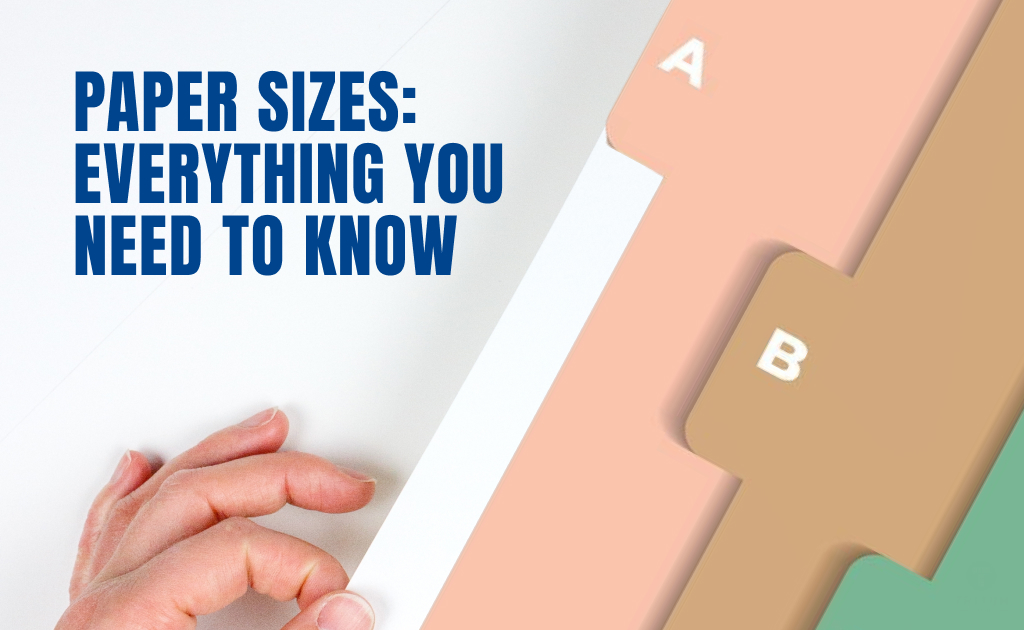
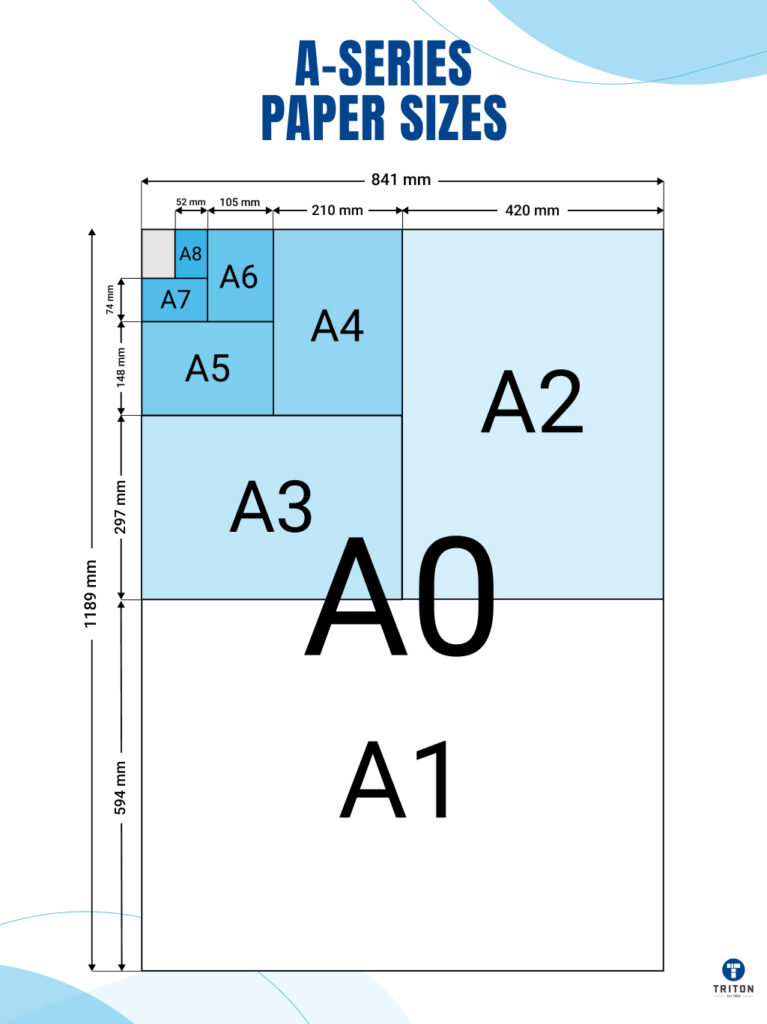
A-series paper sizes are a set of standardised sizes defined by the ISO 216 standard and based on the metric system. They are widely used around the world except in the United States and Canada, with A0 being the largest and each subsequent size (A1, A2, etc.) being half the area of the previous one.
All A-series paper sizes maintain a consistent aspect ratio of √2:1, meaning that when a sheet is cut or folded in half widthways, the two halves retain the same proportions.
This aspect ratio makes resizing documents simple without distorting the layout, which is why the series is ideal for printing. The most commonly used size in the A-series is A4, which is the standard for everyday office printing, letters, and forms
Format | Width x Height (mm) | Width x Height (inch) |
|---|---|---|
4A0 | 1682 x 2378 | 66.2 x 93.6 |
2A0 | 1189 x 1682 | 46.8 x 66.2 |
A0+ | 914 x 1292 | 36 x 50.9 |
A0 | 841 x 1189 | 33.1 x 46.8 |
A1+ | 609 x 914 | 24 x 36 |
A1 | 594 x 841 | 23.4 x 33.1 |
A2 | 420 x 594 | 16.5 x 23.4 |
A3+ | 329 x 483 | 13 x 19 |
A3 | 297 x 420 | 11.7 x 16.5 |
A4 | 210 x 297 | 8.3 x 11.7 |
A5 | 148 x 210 | 5.8 x 8.3 |
A6 | 105 x 148 | 4.1 x 5.8 |
A7 | 74 x 105 | 2.9 x 4.1 |
A8 | 52 x 74 | 2 x 2.9 |
A9 | 37 x 52 | 1.5 x 2 |
A10 | 26 x 37 | 1 x 1.5 |
A11 | 18 x 26 | 0.7 x 1 |
A12 |
13 x 18 | 0.5 x 0.7 |
A13 | 9 x 13 | 0.4 x 0.5 |
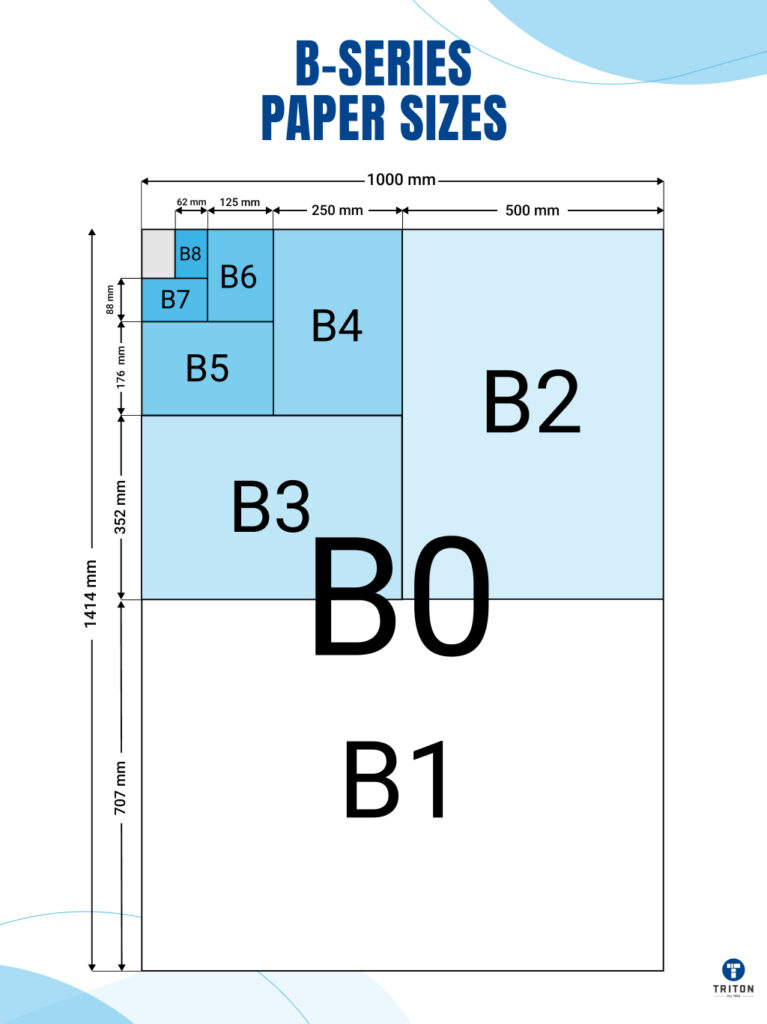
Like the A-series, the B-series paper sizes are defined by the ISO 216 standard and share the same aspect ratio of √2:1.
Although less common than the A-series, the B-series has been widely used worldwide for many years. The B-series was created to offer additional sizes that the A-series doesn’t cover.
In this system, the size of each Bn format is the geometric mean between the corresponding An size and the next larger A(n-1) size.
For instance, B1 falls between A0 and A1 in size. This series is particularly useful for items like envelopes, passports, posters, and books, where more variety in dimensions is needed.
Format | Width x Height (mm) | Width x Height (inch) |
|---|---|---|
B0+ | 1118 x 1580 | 44 x 62.2 |
B0 | 1000 x 1414 | 39.4 x 55.7 |
B1+ | 720 x 1020 | 28.3 x 40.2 |
B1 | 707 x 1000 | 27.8 x 39.4 |
B2 | 500 x 707 | 19.7 x 27.8 |
B3 | 353 x 500 | 13.9 x 19.7 |
B4 | 250 x 353 | 9.8 x 13.9 |
B5 | 176 x 250 | 6.9 x 9.8 |
B6 | 125 x 176 | 4.9 x 6.9 |
B7 | 88 x 125 | 3.5 x 4.9 |
B8 | 62 x 88 | 2.4 x 3.5 |
B9 | 44 x 62 | 1.7 x 2.4 |
B10 | 31 x 44 | 1.2 x 1.7 |
B11 | 22 x 31 | 0.9 x 1.2 |
B12 | 15 x 22 | 0.6 x 0.9 |
B13 | 11 x 15 |
0.4 x 0.6 |
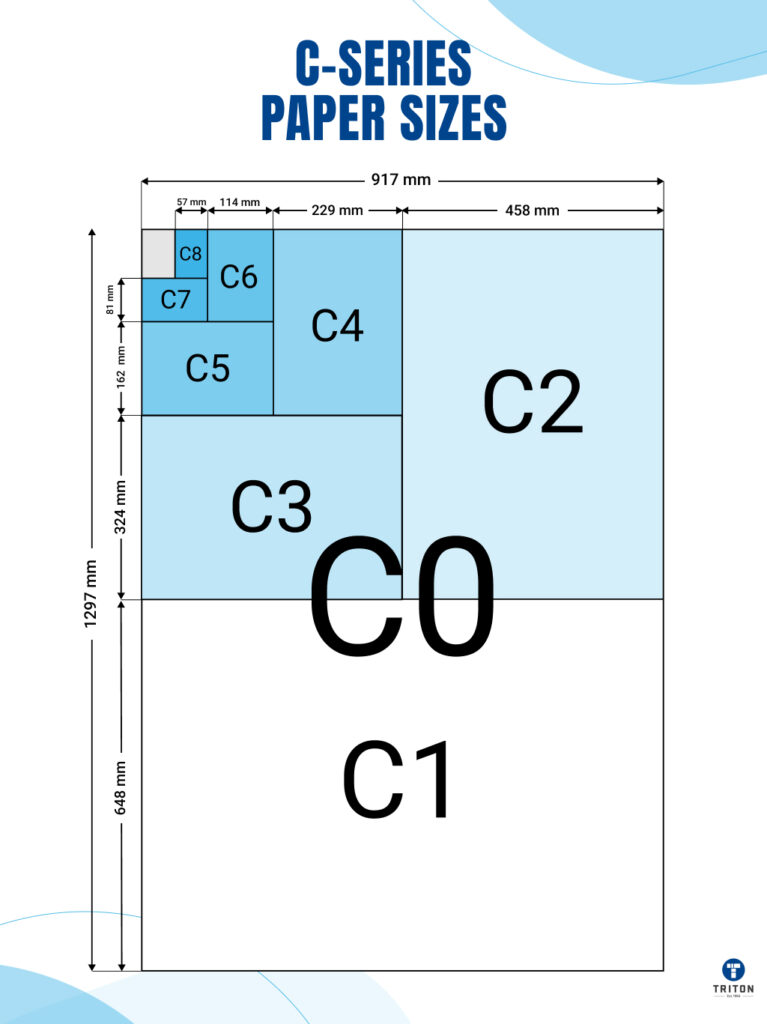
Unlike the A and B series, the C-series paper sizes were initially defined by the now-discontinued ISO 269 standard.
However, countries that adhere to ISO guidelines—such as those in Europe, Australia, and New Zealand—continue to use these measurements, especially for envelopes.
Each Cₙ size is determined as the geometric mean between the corresponding A and B sizes. For example, a C4 envelope falls between A4 and B4 in size, making it ideal for containing an A4 sheet.
The C-series also maintains the √2:1 aspect ratio standard to ISO paper sizes.
This aspect ratio ensures that an A4 sheet fits neatly into a C4 envelope; if folded in half, it fits into a C5 envelope, and a further fold allows it to fit into a C6 envelope.
Format | Width x Height (mm) | Width x Height (inch) |
|---|---|---|
C0 | 917 x 1297 | 36.1 x 51.1 |
C1 | 648 x 917 | 25.5 x 36.1 |
C2 | 458 x 648 | 18 x 25.5 |
C3 | 324 x 458 | 12.8 x 18 |
C4 | 229 x 324 | 9 x 12.8 |
C5 | 162 x 229 | 6.4 x 9 |
C6 | 114 x 162 | 4.5 x 6.4 |
C7 | 81 x 114 | 3.2 x 4.5 |
C8 | 57 x 81 | 2.2 x 3.2 |
C9 | 40 x 57 | 1.6 x 2.2 |
C10 | 28 x 40 | 1.1 x 1.6 |
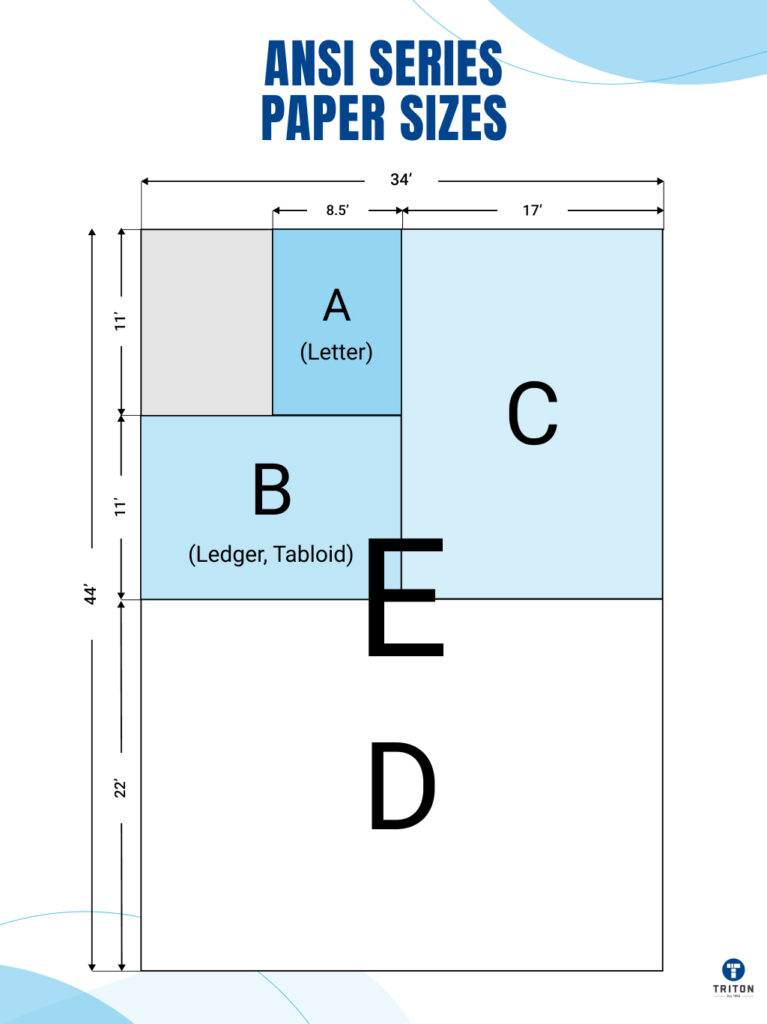
The American National Standards Institute (ANSI) paper series is a widely used standard for paper sizes in the United States, Canada, and Mexico.
In 1996, ANSI adopted the ANSI/ASME Y14.1 standard, introducing a new series of paper sizes similar to the ISO A, B, and C series.
The most popular size in this series is ANSI A, commonly known as Letter size, which measures 8.5 inches x 11 inches (216mm x 279mm) and is widely used for office documents.
Another well-known size is ANSI B, also called Ledger/Tabloid, which is frequently used for larger prints. Like the ISO series, the ANSI series follows a similar logic where folding a paper in half produces the next smaller size in the series.
Format | Width x Height (mm) | Width x Height (inch) | ||
|---|---|---|---|---|
ANSI E | 864 x 1118 | 34 x 44 | ||
ANSI D | 559 x 864 | 22 x 34 | ||
ANSI C | 432 x 559 | 17 x 22 | ||
ANSI B (Ledger & Tabloid) | 279 x 432 | 11 x 17 | ||
ANSI A (Letter) | 216 x 279 | 8.5 x 11 | 40 x 57 | 1.6 x 2.2 |
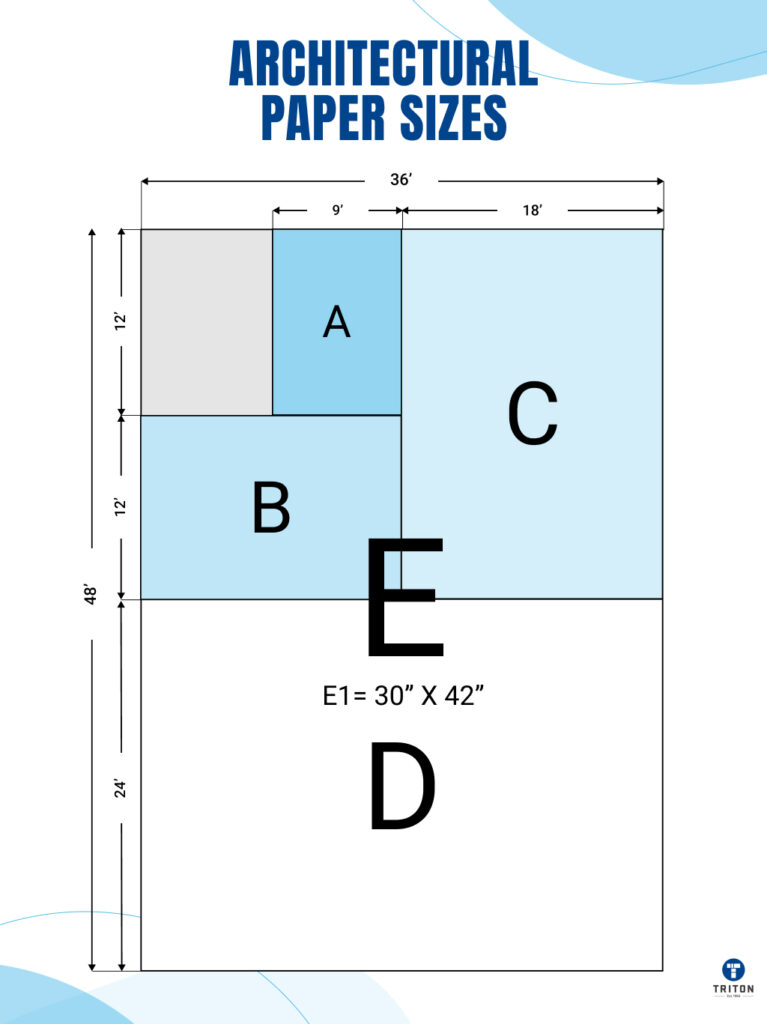
The Architectural series (ARCH) is the most popular paper size standard architects use in North America.
The ARCH series, defined by the ANSI/ASME Y14.1 standard, offers sizes tailored to architectural drawings and designs.
Unlike the ISO or ANSI series, the aspect ratios in the ARCH series are based on smaller whole numbers, such as 4:3 and 3:2, making them ideal for architectural and technical layouts.
Format | Width x Height (mm) | Width x Height (inch) |
|---|---|---|
Arch E | 914 x 1219 | 36 x 48 |
Arch E1 | 762 x 1067 | 30 x 42 |
Arch E3 | 686 x 991 | 27 x 39 |
Arch E2 | 660 x 965 | 26 x 38 |
Arch D | 610 x 914 | 24 x 36 |
Arch C | 457 x 610 | 18 x 24 |
Arch B | 305 x 457 | 12 x 18 |
Arch A | 229 x 305 | 9 x 12 |
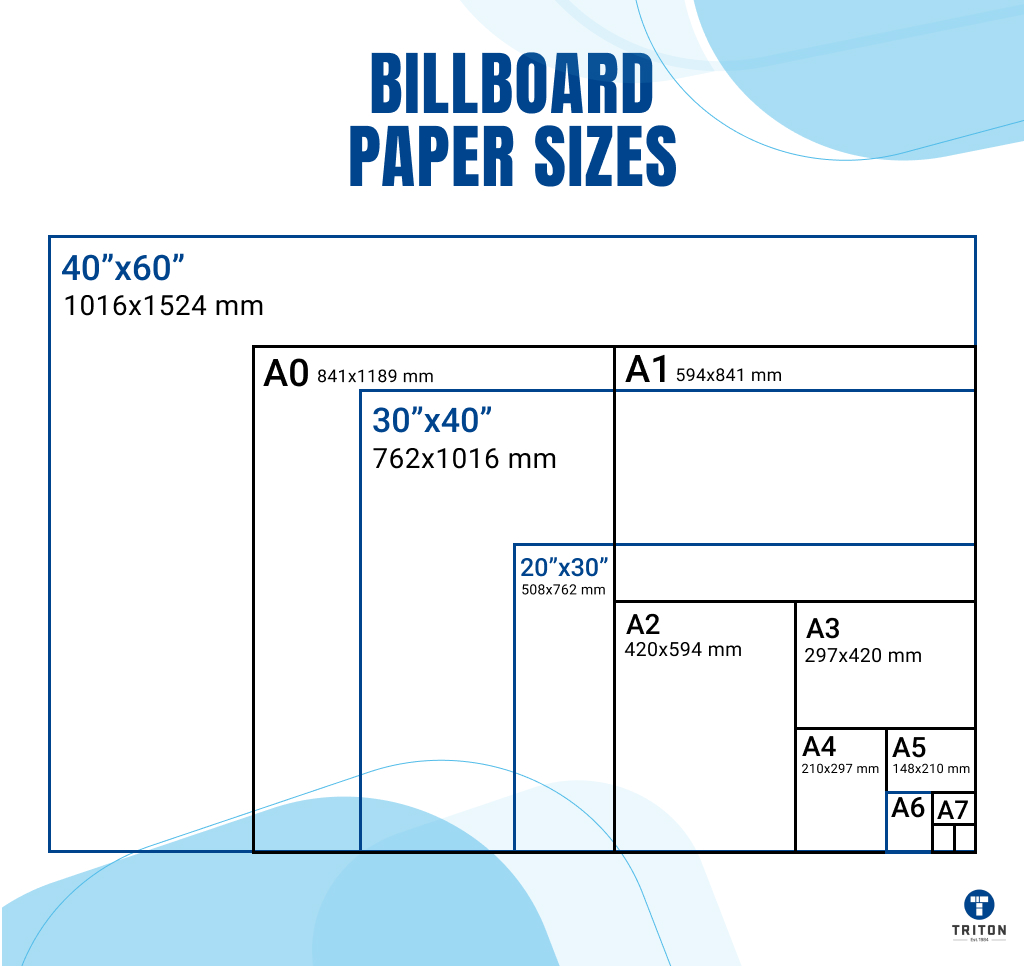
Billboards (or hoardings in the UK) are a widely used form of advertising worldwide. They are designed for large-scale print ads that promote a brand, service, product, company, or campaign.
The largest billboard paper is the Bulletin standard, which measures a whopping 14.6 metres by 4.2 metres. This size is ideal for capturing attention with bold, impactful visuals in high-traffic areas, making it a popular choice for outdoor advertising.
Format | Width x Height (mm) | Width x Height (inch) |
|---|---|---|
Bulletin | 14630 x 4267 | 576 x 168 |
96 Sheet | 12192 x 3048 | 480 x 120 |
64 Sheet | 8128 x 3048 | 320 x 120 |
48 Sheet | 6096 x 3048 | 240 x 120 |
32 Sheet | 4064 x 3048 | 160 x 120 |
12 Sheet | 3048 x 1524 | 120 x 60 |
16 Sheet | 2032 x 3048 | 80 x 120 |
6 Sheet | 1200 x 1800 | 47.2 x 70.9 |
4 Sheet | 1016 x 1524 | 40 x 60 |
2 Sheet | 762 x 1016 | 30 x 40 |
1 Sheet | 508 x 762 | 20 x 30 |

Book dimensions and proportions vary significantly across regions. One of the most common paperback sizes in the United Kingdom is the B Format, which measures 129 mm by 198 mm.
In Europe, similar standards are often observed, although local variations can occur.
In Australia and New Zealand, publishers tend to favour dimensions close to the UK standard, while in the United States, trade paperbacks generally adopt slightly smaller sizes—often around 5.5 x 8.5 inches or 6 x 9 inches – to suit market preferences.
Other notable sizes include the Elephant Folio, which is 23 inches tall; the Atlas Folio, standing at 25 inches tall; and the Double Elephant Folio, which reaches 50 inches in height. These measurements are crucial for categorising books, especially in rare or collector’s editions, where size significantly influences presentation and value.
Folio is the largest paper size in the Books series, followed by progressively smaller formats such as quarto, octavo, and others.
Format | Width x Height (mm) | Width x Height (inch) |
|---|---|---|
Folio | 304.8 x 482.6 | 12 x 19 |
Quarto | 241.3 x 304.8 | 9.5 x 12 |
Imperial Octavo | 209.6 x 292.1 | 8.3 x 11.5 |
Super Octavo | 177.8 x 279.4 | 7 x 11 |
Medium Octavo | 165.1 x 234.9 | 6.5 x 9.3 |
Royal Octavo | 165.1 x 254 | 6.5 x 10 |
Octavo | 152.4 x 228.6 | 6 x 9 |
Crown Octavo | 136.5 x 203.2 | 5.4 x 8 |
C Format | 135 x 216 | 5.3 x 8.5 |
B Format | 129 x 198 | 5.1 x 7.8 |
12mo |
127 x 187.3 |
5 x 7.4 |
A Format | 110 x 178 | 4.3 x 7 |
18mo | 101.6 x 165.1 | 4 x 6.5 |
16mo | 101.6 x 171.4 | 4 x 6.8 |
32mo |
3.5 x 5.5 | 0.6 x 0.9 |
48mo | 63.5 x 101.6 |
2.5 x 4 |
64mo | 50.8 x 76.2 | 2 x 3 |
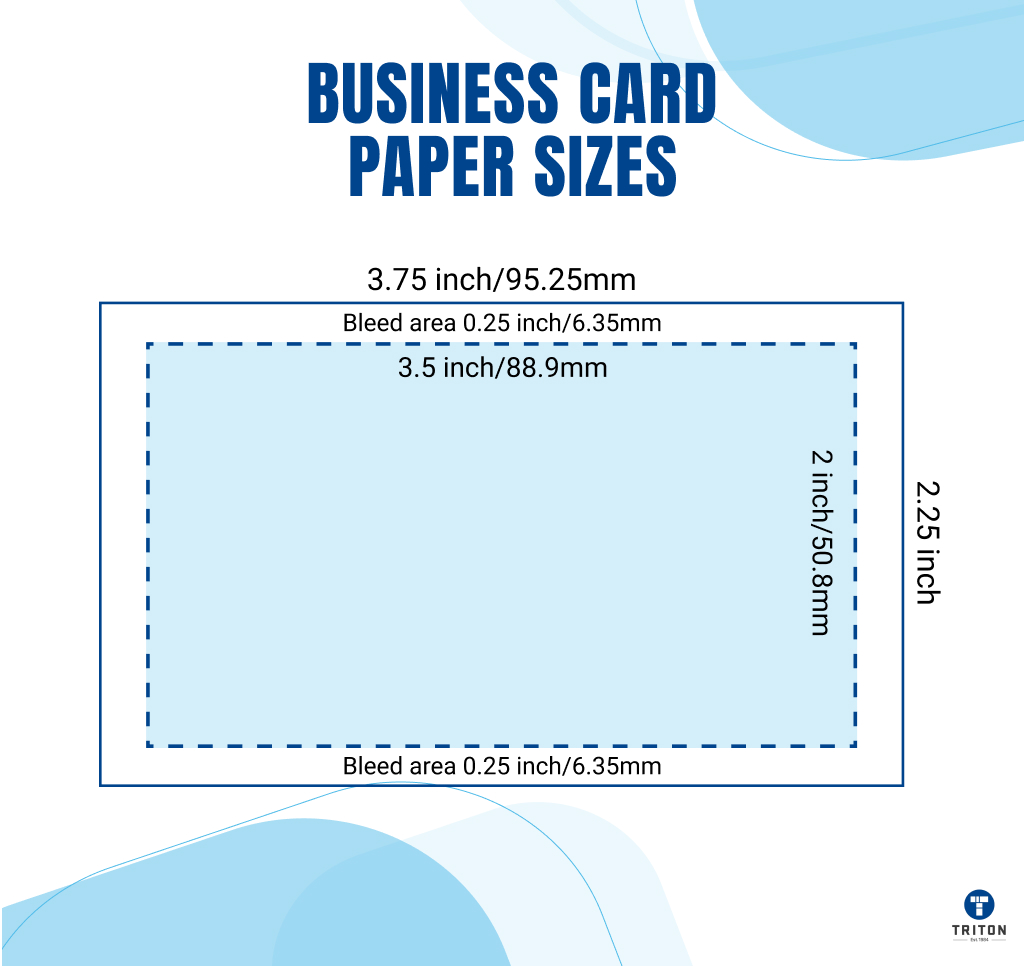
Business cards remain an essential tool in professional networking, and their dimensions vary by region to align with local standards for practicality and convenience.
The standard size of a business card in Europe is 85 mm x 55 mm. This size is very close to the dimensions of banking cards, which makes them easy to handle and portable.
Meanwhile, the standard size changes slightly to 89 mm x 51 mm (3.5 inches x 2 inches) in Canada, the United States, Australia, and New Zealand.
Although the traditional rectangular shape is still the most common, there is an increasing trend in creative fields towards more innovative designs, including square and rounded rectangular cards, mirroring modern design preferences.
Business cards based on the ISO 216 standard, such as the A8 size, measure 74 mm x 52 mm, offering another practical option in the global business environment.
Format | Width x Height (mm) | Width x Height (inch) |
|---|---|---|
Japan Business Card | 91 x 55 | 3.6 x 2.2 |
China Business Card | 90 x 54 | 3.5 x 2.1 |
Scandinavia Business Card | 90 x 55 | 3.5 x 2.2 |
US/Canada Business Card | 88.9 x 50.8 | 3.5 x 2 |
ISO 7810 ID-1 Business Card | 85.6 x 54 | 3.4 x 2.1 |
Iran Business Card | 85 x 48 | 3.3 x 1.9 |
European Business Card | 85 x 55 | 3.3 x 2.2 |
ISO 216 Business Card | 74 x 52 | 2.9 x 2 |
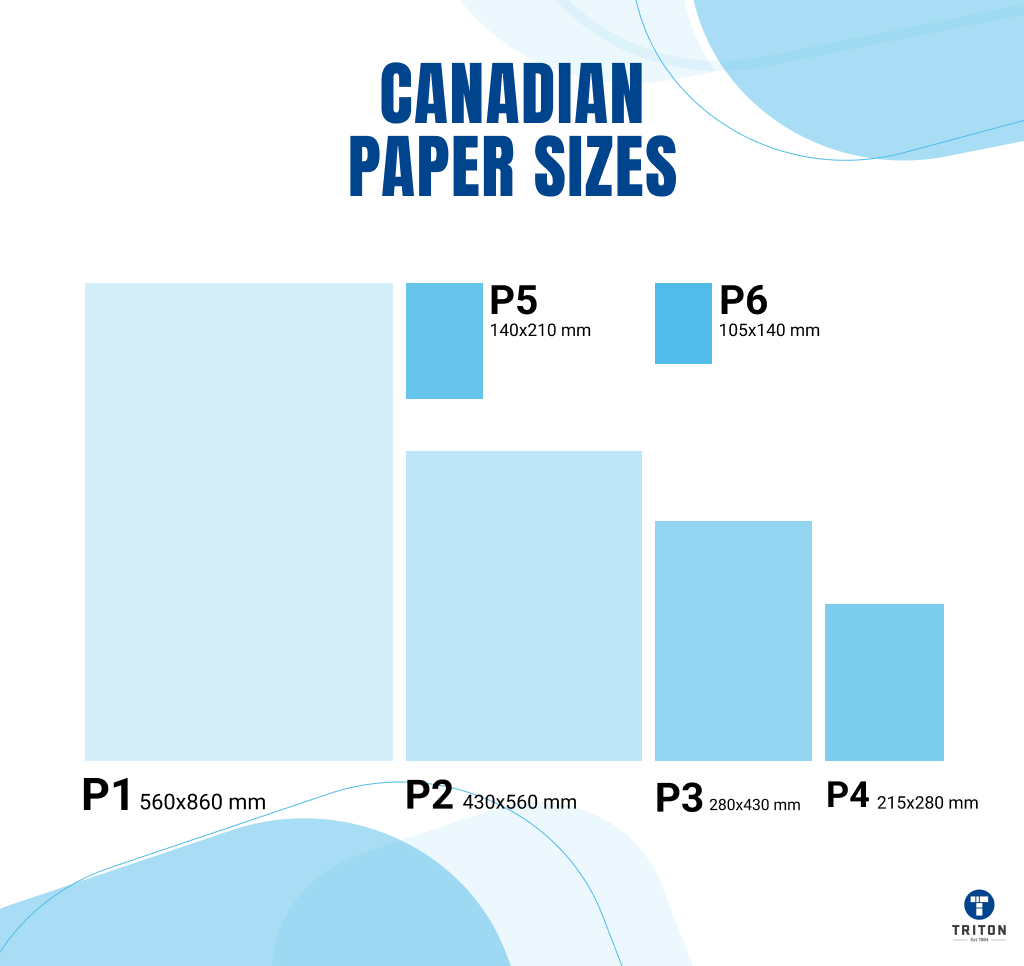
Canadian paper sizes are based on the CAN 2-9.60M standard, which defines the dimensions of paper commonly used in Canada. These sizes are similar to the US ANSI paper sizes, with a difference of approximately 5mm. The P series of Canadian paper sizes includes formats from P1 to P6, which align with ANSI sizes such as A, B, C, and D, along with two smaller sizes that fall below the ANSI A size.
Although the P series was once widely used, it is now considered outdated and is rarely used. The Canadian P series does not share the same aspect ratio, unlike the ISO standard sizes. This difference makes it more challenging to resize documents between the two standards, as stretching or shrinking paper sizes becomes more complex due to the lack of proportional consistency.
Format | Width x Height (mm) | Width x Height (inch) |
|---|---|---|
P1 | 560 x 860 | 22 x 33.9 |
P2 | 430 x 560 | 16.9 x 22 |
P3 | 280 x 430 | 11 x 16.9 |
P4 | 215 x 280 | 8.5 x 11 |
P5 | 140 x 215 | 5.5 x 8.5 |
P6 | 107 x 140 | 4.2 x 5.5 |
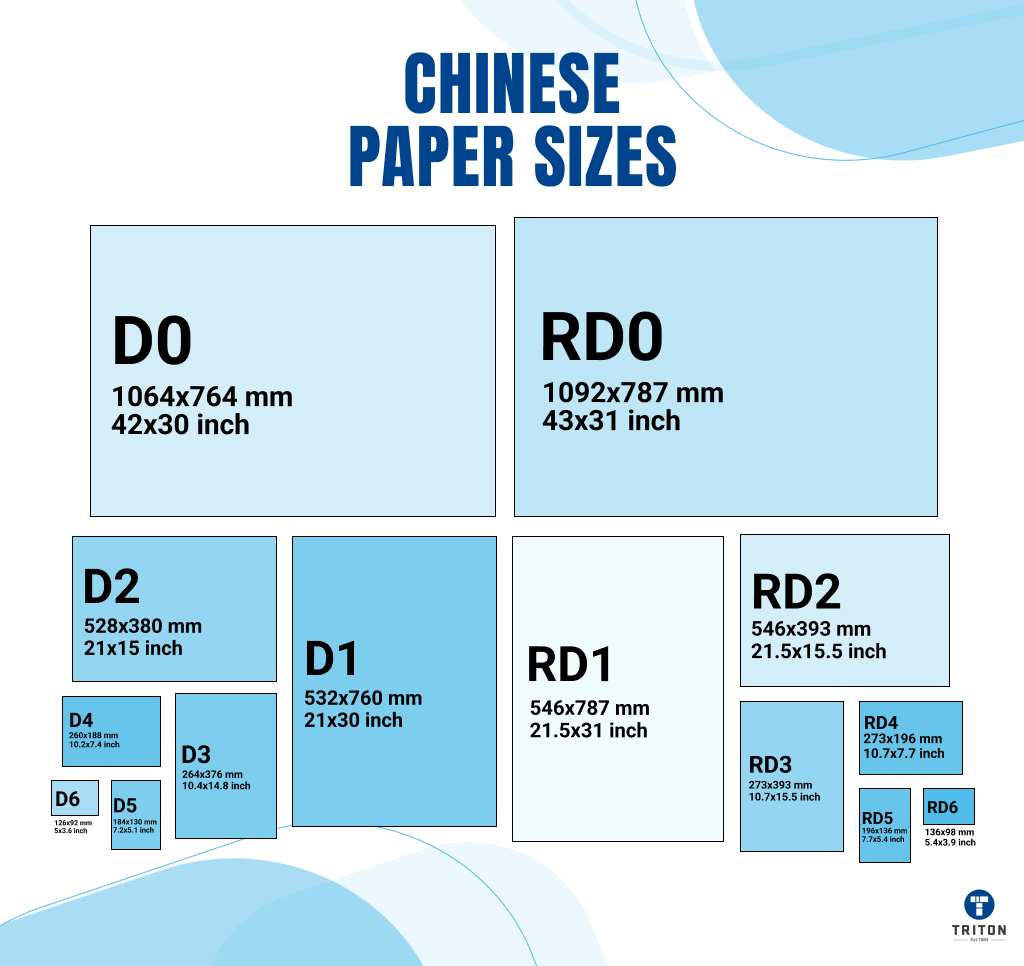
Chinese paper sizes are governed by the GB/T 148-1997 standard, which defines the dimensions used in China. While this standard is similar to the ISO series, it does not fully align with the same principles.
From 1912 to 1949, the Republic of China introduced its unique paper format, the D series, which is distinct from the one used in Sweden.
The Chinese D paper size standard is part of the GB/T 148-1997 national standard, which governs paper formats in China.
While this standard primarily adopts the ISO 216 A series (e.g., A4, A3) for general use, it also includes a D series tailored for specific applications, such as posters, packaging, and specialised printing. The ISO A series (e.g., A0 = 841×1189 mm) is widely adopted in China for general printing, while the D series serves specialised needs.
Format | Width x Height (mm) | Width x Height (inch) |
|---|---|---|
RD0 | 787 x 1092 | 31 x 43 |
D0 | 764 x 1064 | 30.1 x 41.9 |
RD1 | 546 x 787 | 21.5 x 31 |
D1 | 532 x 760 | 20.9 x 29.9 |
RD2 | 393 x 546 | 15.5 x 21.5 |
D2 | 380 x 528 | 15 x 20.8 |
RD3 | 273 x 393 | 10.7 x 15.5 |
D3 | 264 x 376 |
10.4 x 14.8 |
RD4 | 196 x 273 | 7.7 x 10.7 |
D4 | 188 x 260 | 7.4 x 10.2 |
RD5 | 136 x 196 | 5.4 x 7.7 |
D5 | 130 x 184 | 5.1 x 7.2 |
RD6 | 98 x 136 | 3.9 x 5.4 |
D6 | 92 x 126 | 3.6 x 5 |
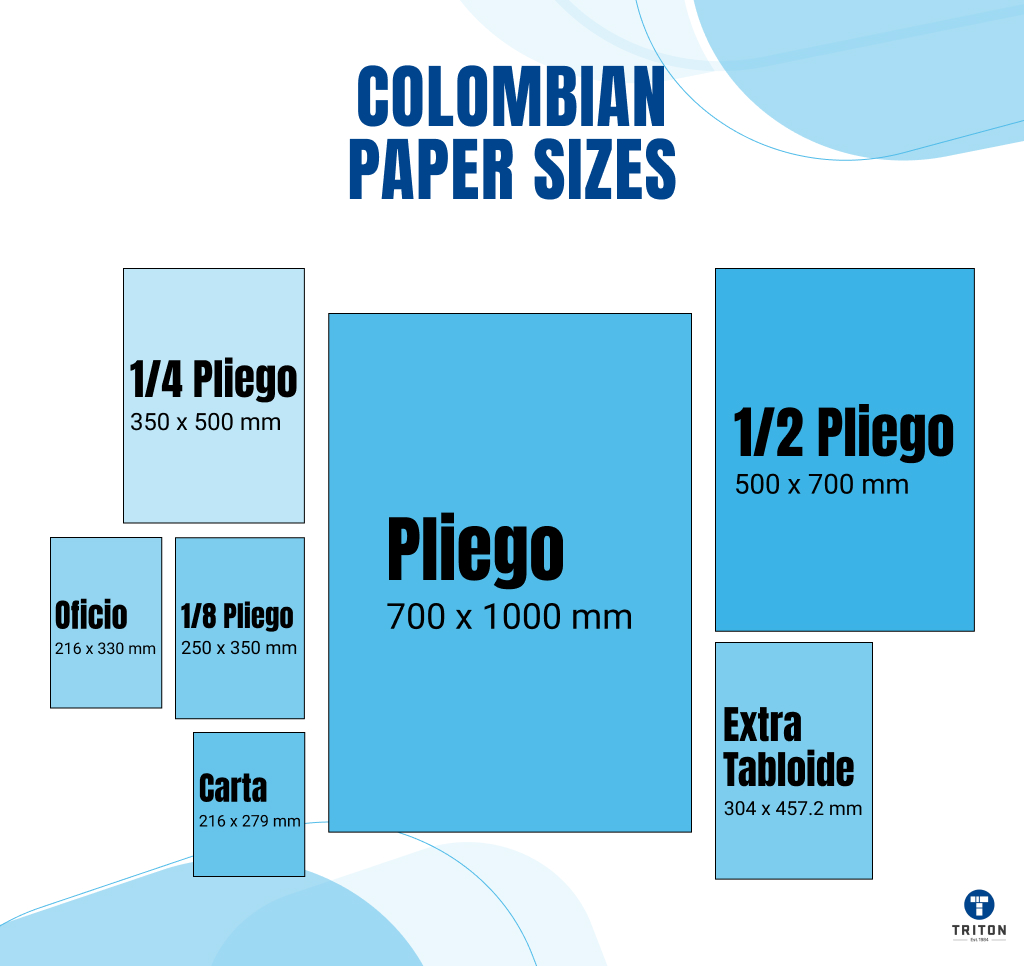
Colombian paper sizes are based on the ISO B1 standard (707mm x 1000mm), commonly called Pliego.
These paper sizes are widely used in industrial and business printing across Colombia. Smaller sizes are created by reducing the Pliego by half, resulting in formats like ½ Pliego, ¼ Pliego, and ⅛ Pliego, which are practical for different printing needs.
Other commonly used paper sizes in Colombia include Oficio, Extra Tabloide, and Carta, which are used for various business and legal documents.
Format | Width x Height (mm) | Width x Height (inch) |
|---|---|---|
Pliego | 700 x 1000 | 27.6 x 39.4 |
1/2 Pliego | 500 x 700 | 19.7 x 27.6 |
1/4 Pliego | 350 x 500 | 13.8 x 19.7 |
Extra Tabloide | 304 x 457.2 | 12 x 18 |
1/8 Pliego | 250 x 350 | 9.8 x 13.8 |
Oficio | 216 x 330 | 8.5 x 13 |
Carta |
216 x 279 | 8.5 x 11 |
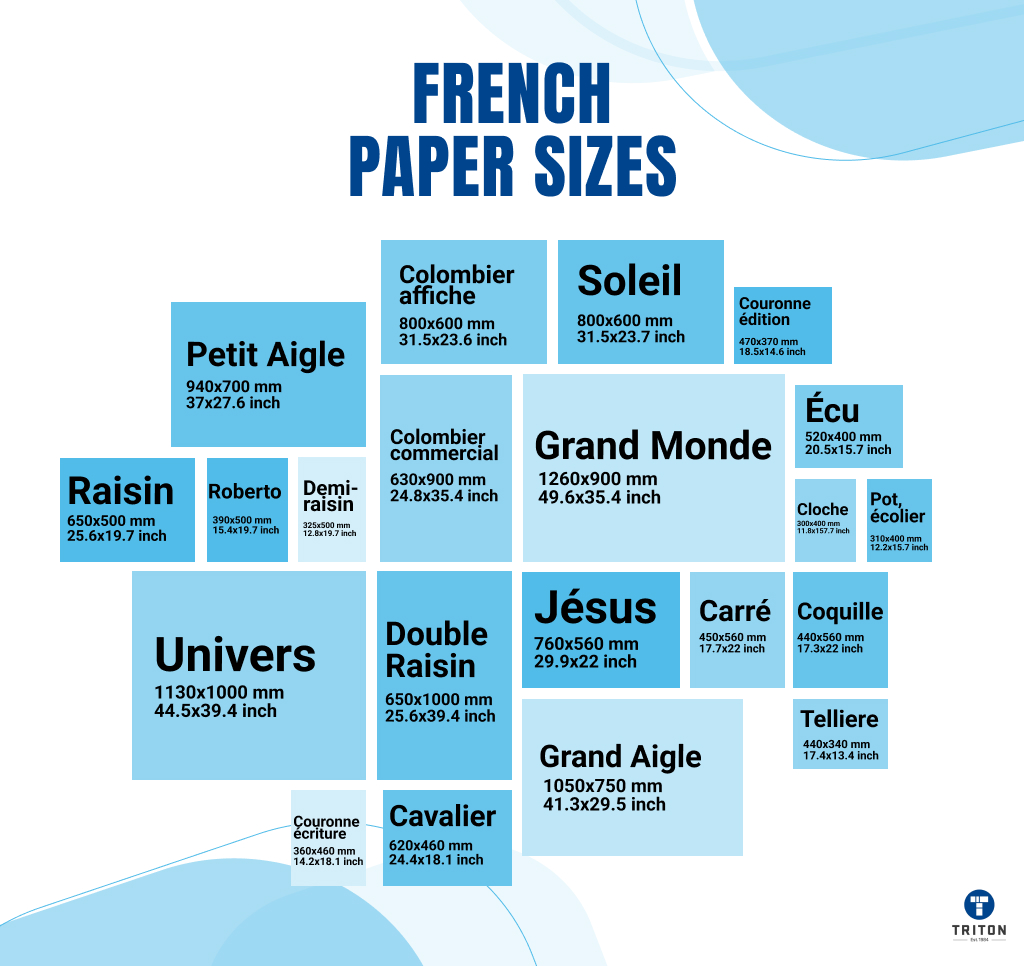
The paper size standard in France started using the ISO in 1967, but France had its paper size structure before this. In 1926, the AFNOR standard paper format was established, and the paper formats in this system followed France’s paper patterns.
These paper formats are still in use today. When paper is made by hand, it is marked with watermarks. The watermarks symbolise the name of the paper and where it came from. Some versions of the formats are known as double or quadruple variants.
Examples of a quadruple variant are Soleil (600mm x 800mm) and Cloche (300mm x 400mm). Grand Monde (900mm x 1260mm) and Carré (450mm x 560mm) are from the double variant.
Format | Width x Height (mm) | Width x Height (inch) |
|---|---|---|
Univers | 1000 x 1130
| 39.4 x 44.5 |
Grand Monde | 900 x 1260
| 35.4 x 49.6 |
Grand Aigle | 750 x 1050 | 29.5 x 41.3 |
Petit Aigle | 700 x 940 | 27.6 x 37 |
Double Raisin | 650 x 1000 | 25.6 x 39.4 |
Colombier Commercial | 630 x 900 | 24.8 x 35.4 |
Colombier Affiche | 600 x 800 | 23.6 x 31.5 |
Soleil | 600 x 800 | 23.6 x 31.5 |
Jésus | 560 x 760 | 22 x 29.9 |
Raisin | 500 x 650 | 19.7 x 25.6 |
Cavalier | 460 x 620 |
18.1 x 24.4 |
Carré | 450 x 560 | 17.7 x 22 |
Coquille | 440 x 560 | 17.3 x 22 |
Écu | 400 x 520 | 15.7 x 20.5 |
Roberto | 390 x 500 | 15.4 x 19.7 |
Couronne Édition | 370 x 470 | 14.6 x 18.5 |
Couronne Écriture | 360 x 360 | 14.2 x 14.2 |
Tellière | 340 x 440 |
13.4 x 17.3 |
Demi-Raisin | 325 x 500 | 12.8 x 19.7 |
Pot, Écolier | 310 x 400 | 12.2 x 15.7 |
Cloche | 300 x 400 | 11.8 x 15.7 |
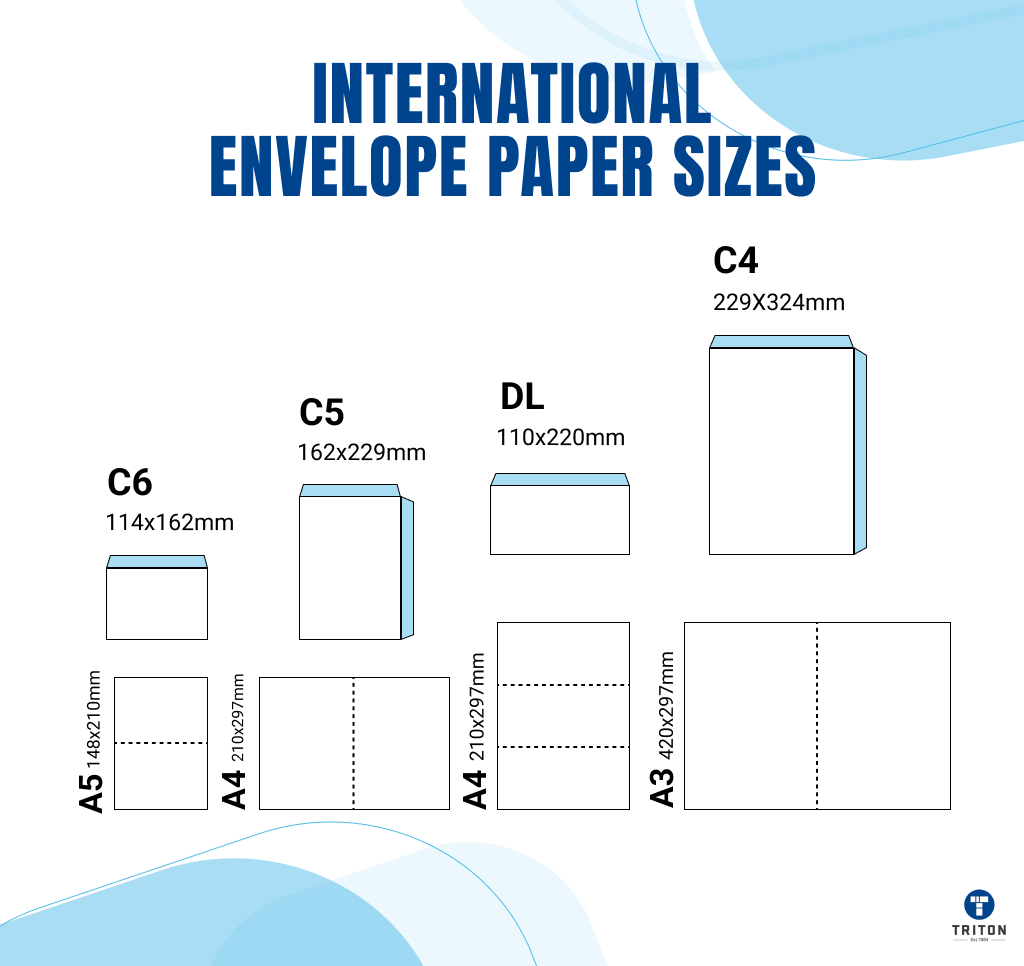
Earlier, ISO 269 was the international standard that defined standard envelope sizes. Since it has been withdrawn, envelope sizes are still primarily defined and aligned with the ISO 216 paper sizes,
The most commonly used envelope sizes come from the C series, with a C4 envelope being perfectly sized to hold an A4 sheet of paper.
One notable exception is the DL envelope (short for Dimension Lengthwise), which originated in Germany in the 1920s, previously known as DIN Lang. The DL envelope doesn’t follow the C series due to its different aspect ratio, but it’s widely used to fit an A4 paper folded into thirds.
Format | Width x Height (mm) | Width x Height (inch) |
|---|---|---|
C3 Envelope | 458 x 324 |
18 x 12.8 |
E4 Envelope | 400 x 280 | 15.7 x 11 |
RD1 | 546 x 787 | 21.5 x 31 |
B4 Envelope | 353 x 250 | 9.8 x 6.9 |
C4 Envelope | 324 x 229 | 12.8 x 9 |
C6/C5 Envelope | 229 x 114 | 9 x 4.5 |
C5 Envelope | 229 x 162 | 9 x 6.4 |
DL Envelope |
220 x 110 | 8.7 x 4.3 |
B6 Envelope | 176 x 125 | 6.9 x 4.9 |
C7/C6 Envelope | 162 x 81 | 6.4 x 3.2 |
C6 Envelope | 162 x 114 | 6.4 x 4.5 |
C7 Envelope | 114 x 81 | 4.5 x 3.2 |
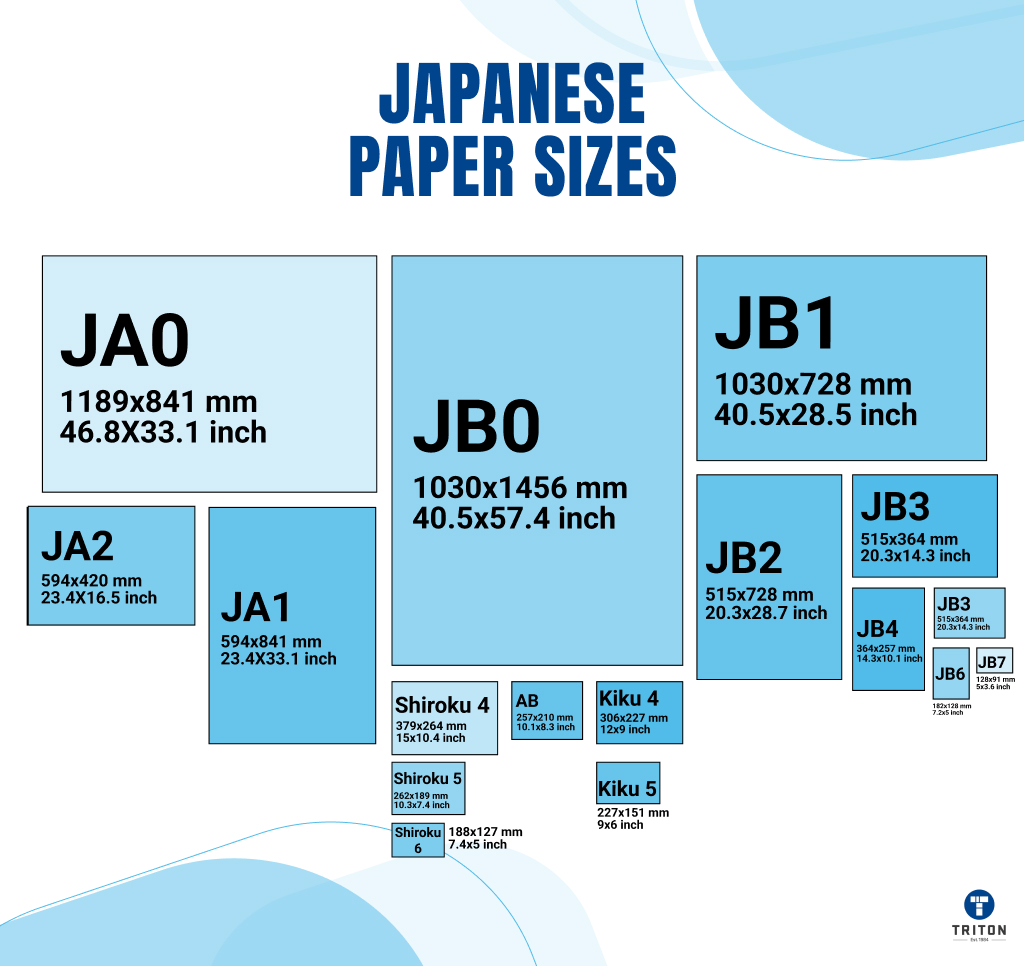
The Japanese Industrial Standards (JIS) define two main series of paper sizes: the JIS A series and the JIS B series. These standards are widely used in Japan, Taiwan, and China.
The JIS A series is almost identical to the ISO A series, the only difference being the tolerances applied during production. Both the JIS A and JIS B series share the same aspect ratio of √2:1, but JIS B paper is 1.5 times larger than its A-series counterpart.
In addition, traditional Japanese paper sizes such as Shiroku-ban and Kiku are commonly used by printers in Japan.
Format | Width x Height (mm) | Width x Height (inch) |
|---|---|---|
JB0 | 1030 x 1456 | 40.6 x 57.3 |
JB1 | 728 x 1030 | 28.7 x 40.6 |
JB2 | 515 x 728 | 20.3 x 28.7 |
JB3 | 364 x 515 | 14.3 x 20.3 |
Shiroku Ban 4 | 264 x 379 | 10.4 x 14.9 |
JB4 | 257 x 364 | 10.1 x 14.3 |
Kiku 4 | 227 x 306 | 8.9 x 12 |
Shiroku Ban 5 | 189 x 262 | 7.4 x 10.3 |
JB5 | 182 x 257 | 7.2 x 10.1 |
Kiku 5 | 151 x 227 | 5.9 x 8.9 |
JB6 | 128 x 182 | 5 x 7.2 |
Shiroku Ban 6 | 127 x 188 | 5 x 7.4 |
JB7 | 91 x 128 | 3.6 x 5 |
JB8 | 64 x 91 | 2.5 x 3.6 |
JB9 | 45 x 64 | 1.8 x 2.5 |
JB12 | 16 x 22 | 0.6 x 0.9 |
JB10 | 33 × 46 | 1.3 x 1.8 |
JB11 | 23 × 33 | 0.9 x 1.3 |
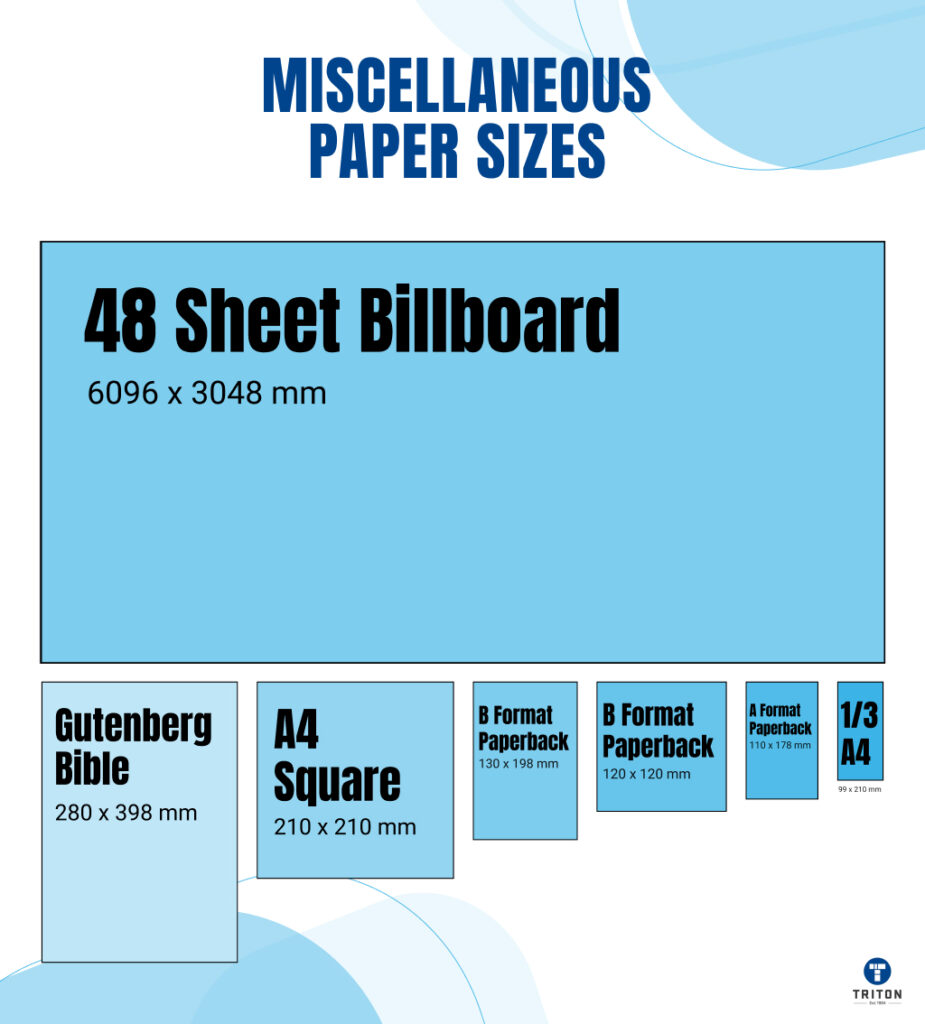
This group includes a variety of both common and uncommon paper sizes. One notable example is the Gutenberg Bible, also known as the B42, Mazarin Bible, or 42-line Bible, which was among the first major books printed using mass-produced movable metal type in Europe.
Another example in this category is the CD Case Insert paper size, commonly used to create custom designs for CD case covers.
Format | Width x Height (mm) | Width x Height (inch) |
|---|---|---|
48 Sheet Billboard | 6096 x 3048 | 240 x 120 |
Gutenberg Bible | 280 x 398 | 11 x 15.7 |
A4 Square | 210 x 210 | 8.3 x 8.3 |
B Format Paperback | 130 x 198 | 5.1 x 7.8 |
CD Case Insert | 120 x 120 | 4.7 x 4.7 |
A Format Paperback | 110 x 178 | 4.3 x 7 |
1/3 A4 | 99 x 210 | 3.9 x 8.3 |

The Newspaper category includes 15 paper sizes, the largest being the Broadsheet.
This format gets its name from the early single-page prints featuring various content types. Broadsheets are known for their long vertical pages and are commonly used for in-depth reporting.
Newspaper formats vary from country to country. Other popular formats include Tabloids and Berliners, which are smaller than the Broadsheet.
Format | Width x Height (mm) | Width x Height (inch) |
|---|---|---|
Broadsheet | 597 x 749 | 23.5 x 29.5 |
South African Broadsheet | 410 x 578 | 16.1 x 22.8 |
Nordisch | 400 x 570 | 15.7 x 22.4 |
US Broadsheet | 381 x 578 | 15 x 22.8 |
British Broadsheet | 375 x 597 | 14.8 x 23.5 |
Rhenish | 350 x 520 | 13.8 x 20.5 |
Ciner | 350 x 500 | 13.8 x 19.7 |
Swiss | 320 x 475 | 12.6 x 18.7 |
Berliner | 315 x 470 | 12.4 x 18.5 |
Wall Street Journal | 305 x 578 | 12 x 22.8 |
New York Times | 305 x 559 | 12 x 22 |
Norwegian Tabloid | 280 x 400 | 11 x 15.7 |
Tabloid | 280 x 430 | 11 x 16.9 |
Compact | 280 x 430 | 11 x 16.9 |
Canadian Tabloid | 260 x 368 | 10.2 x 14.5 |

The ISO 217:2013 standard defines the RAW series paper sizes, which consist of two subcategories: the SRA series and the RA series. SRA stands for ‘Supplementary Raw Format A,’ while RA means ‘Raw Format A’.
These paper sizes are untrimmed and primarily used in commercial printing. RAW paper is slightly larger than the corresponding A-series sizes, allowing for bleed printing, where ink extends to the edge of the paper. After printing, the paper is cut to match the A format.
Format | Width x Height (mm) | Width x Height (inch) |
|---|---|---|
SRA0 | 900 x 1280
| 35.4 x 50.4 |
A0U | 880 x 1230
| 34.6 x 48.4 |
RA0 | 860 x 1220 |
33.9 x 48 |
SRA1+ | 660 x 920 |
26 x 36.2 |
SRA1 | 640 x 900 | 25.2 x 35.4 |
A1U |
625 x 880 |
24.6 x 34.6 |
RA1 | 610 x 860 | 24 x 33.9 |
SRA2+ | 480 x 650 | 18.9 x 25.6 |
A2U | 450 x 625 | 17.7 x 24.6 |
SRA2 | 450 x 640 | 17.7 x 25.2 |
RA2 | 430 x 610 | 16.9 x 24 |
A3U | 330 x 450 | 13 x 17.7 |
SRA3++ |
320 x 464 | 12.6 x 18.3 |
SRA3+ | 320 x 460 |
12.6 x 18.1 |
SRA3 | 320 x 450 | 12.6 x 17.7 |
RA3 | 305 x 430 | 12 x 16.9 |
A4U | 240 x 330 | 9.4 x 13 |
SRA4 | 225 x 320 | 8.9 x 12.6 |
RA4 | 215 x 305 | 8.5 x 12 |
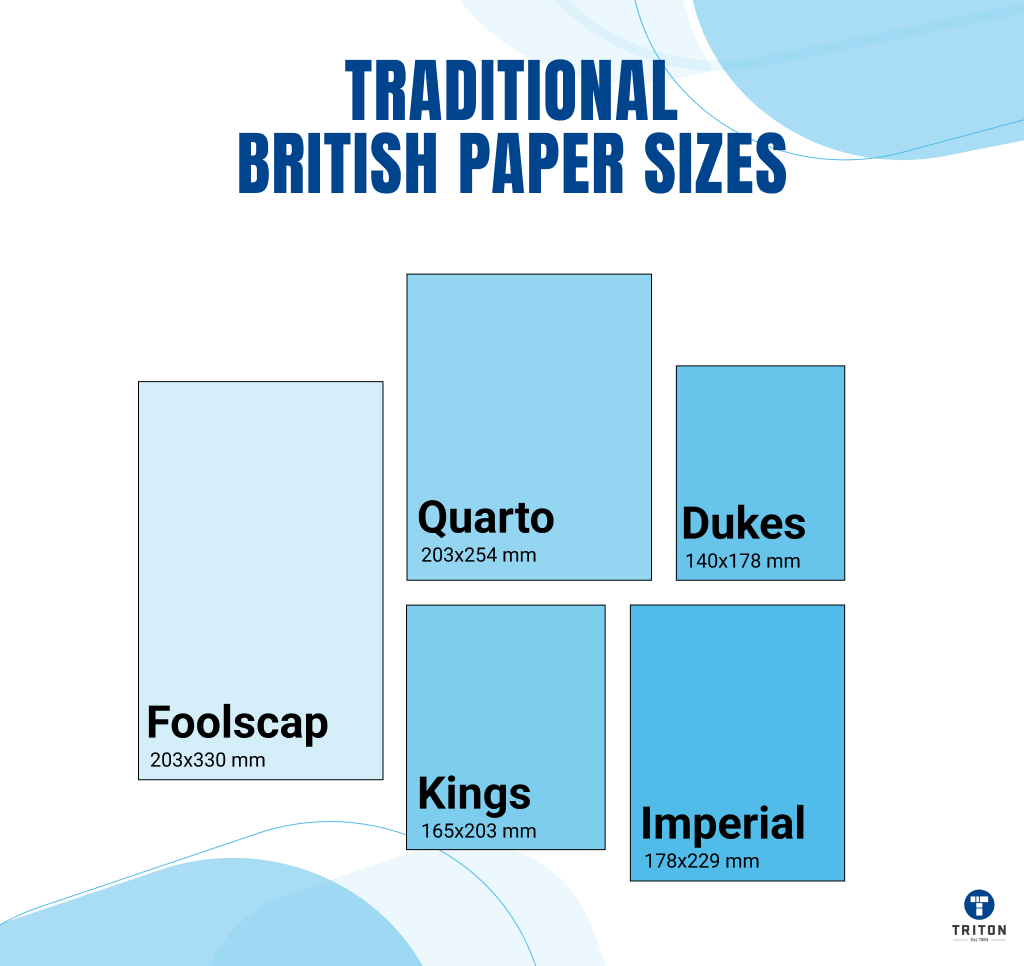
Traditional British paper sizes, such as Demy, Foolscap, and Royal, were once widely used in the UK but are now largely obsolete.
These sizes have been replaced by the ISO 216 standard (A-series paper sizes) since the UK officially adopted it. However, some industries, like publishing, printing, and bookbinding, may still reference these traditional sizes, particularly for historical, specialised, or custom projects.
In everyday use and most business applications, the ISO A-series is now the dominant paper size standard in the UK.
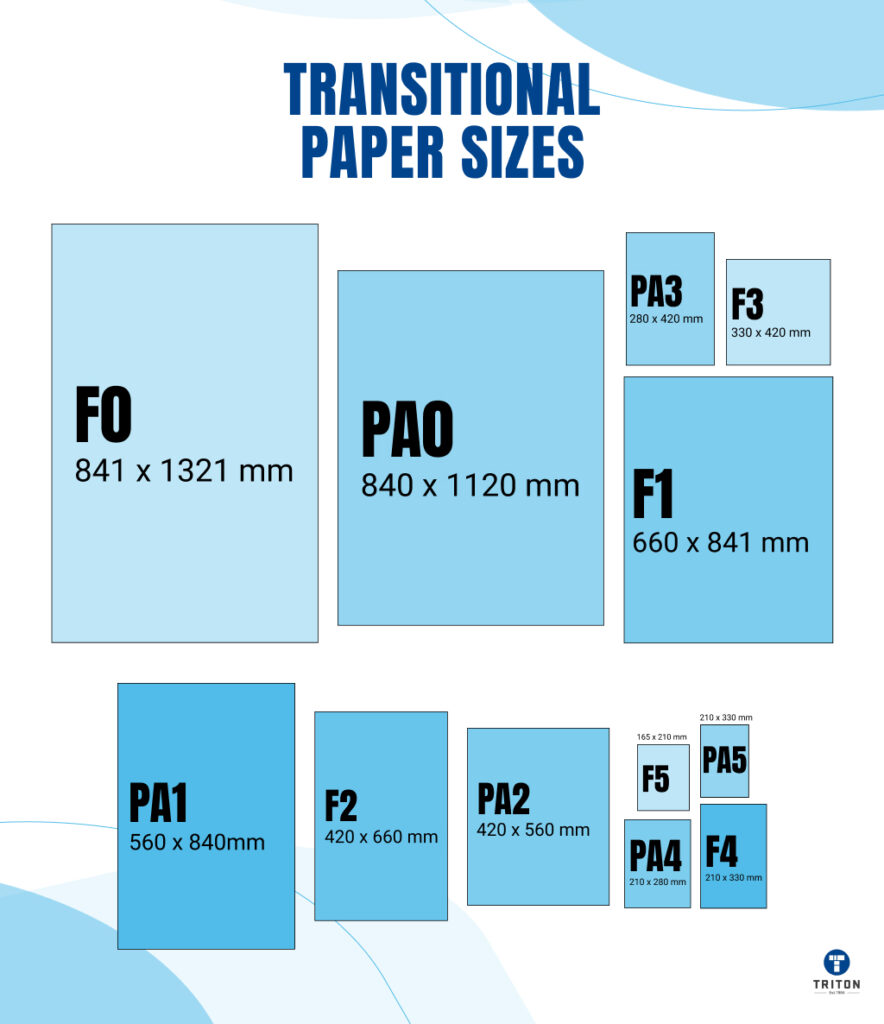
Transitional paper sizes were used during the shift from older national or regional paper standards to the more modern ISO 216 standard (A-series).
These sizes were meant to bridge the gap between traditional formats, such as British Imperial or American sizes, and the newer ISO standards.
However, transitional sizes are now rarely used, as most countries, including the UK and much of Europe, have fully transitioned to the ISO system.
In specific sectors like archiving, historical printing, or custom projects, transitional sizes may still be referenced, but they are generally considered obsolete for modern business and printing practices.
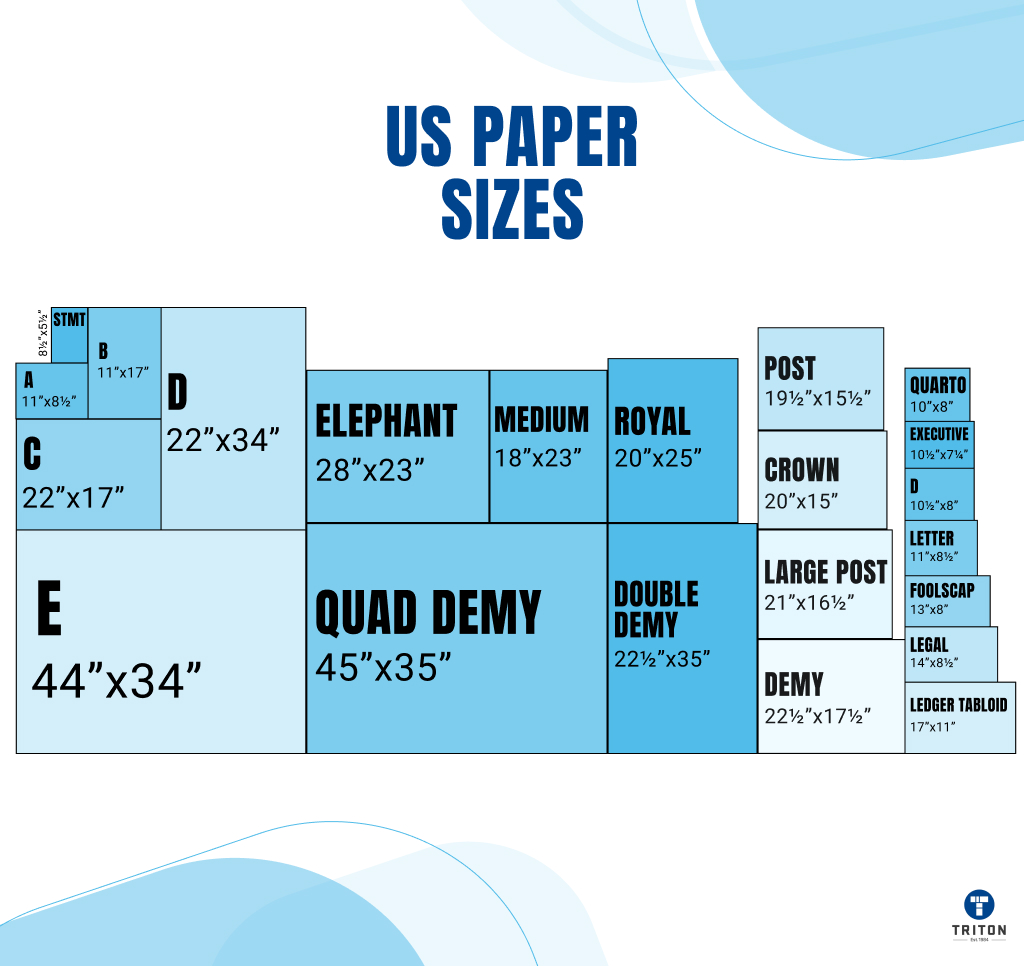
In North America, including the United States, parts of Mexico, and Canada, a different system for paper sizes is used, unlike the ISO standard.
This system makes it more challenging to scale paper sizes consistently. Aside from the sizes defined in the ASME Y14.1M standard for Metric Drawing Sheet Size & Format, commonly used paper sizes include Letter, Ledger/Tabloid, Legal, and Executive.
One of the most popular paper sizes in the US, Chile, and the Philippines is the US Letter size.
In conclusion, understanding paper sizes across formats and regions is essential for precise printing and design. Explore our comprehensive guide and elevate your projects with perfect label and printer solutions.
Visit Triton Store today to discover quality products and unmatched service. Experience innovation and reliability that empower your creative journey.
Melbourne
Brisbane
Phone 1300 558 438
Live Chat – Widget below
Melbourne
Brisbane
Phone 1300 558 438
Live Chat – Widget below